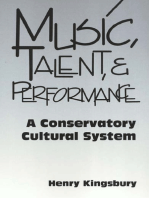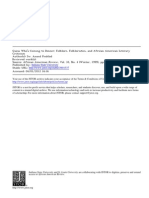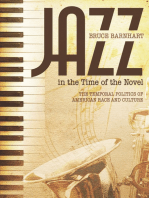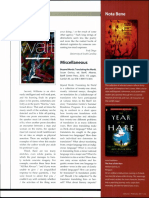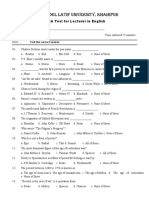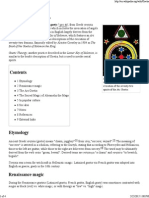Professional Documents
Culture Documents
Blues in The Classroom Author(s) : Frederick E. Danker Source: The English Journal, Mar., 1973, Vol. 62, No. 3 (Mar., 1973), Pp. 394-401 Published By: National Council of Teachers of English
Blues in The Classroom Author(s) : Frederick E. Danker Source: The English Journal, Mar., 1973, Vol. 62, No. 3 (Mar., 1973), Pp. 394-401 Published By: National Council of Teachers of English
Uploaded by
midnightOriginal Description:
Original Title
Copyright
Available Formats
Share this document
Did you find this document useful?
Is this content inappropriate?
Report this DocumentCopyright:
Available Formats
Blues in The Classroom Author(s) : Frederick E. Danker Source: The English Journal, Mar., 1973, Vol. 62, No. 3 (Mar., 1973), Pp. 394-401 Published By: National Council of Teachers of English
Blues in The Classroom Author(s) : Frederick E. Danker Source: The English Journal, Mar., 1973, Vol. 62, No. 3 (Mar., 1973), Pp. 394-401 Published By: National Council of Teachers of English
Uploaded by
midnightCopyright:
Available Formats
Blues in the Classroom
Author(s): Frederick E. Danker
Source: The English Journal , Mar., 1973, Vol. 62, No. 3 (Mar., 1973), pp. 394-401
Published by: National Council of Teachers of English
Stable URL: https://www.jstor.org/stable/813795
JSTOR is a not-for-profit service that helps scholars, researchers, and students discover, use, and build upon a wide
range of content in a trusted digital archive. We use information technology and tools to increase productivity and
facilitate new forms of scholarship. For more information about JSTOR, please contact [email protected].
Your use of the JSTOR archive indicates your acceptance of the Terms & Conditions of Use, available at
https://about.jstor.org/terms
National Council of Teachers of English is collaborating with JSTOR to digitize, preserve and
extend access to The English Journal
This content downloaded from
161.45.205.103 on Sun, 04 Apr 2021 12:17:47 UTC
All use subject to https://about.jstor.org/terms
Blues in the Classroom
Frederick E. Danker
Department of English
Massachusetts State College
Boston, Massachusetts
have to be made. My own teaching ex-
RECENT events suggest that Ameri-
can literature as taught in the secon- perience with textbooks over the last
dary school classroom and even at the fifteen years in high school and junior
college level may finally be less elitist college classrooms has convinced me that
and become concerned with the oral few editors of American literature an-
and written literatures of America's thologies have the slightest idea of our
minorities. The essays in the NCTE's
oral literature. If they do include a sec-
report Searching for America vividly-
tion on black poetry, they seldom in-
clude folk material; when it is there we
and often angrily-reveal the inadequa-
cies of nearly all standard college find
texts
the same few ballads, spirituals, or
in American literature in the areas of
work songs-the black blues are absent.
black, Chicano, Indian, and Asian-Amer-
Yet LeRoi Jones suggests that "the
ican literatures. Gerald Haslam's article literature of the blues is a much more
"American Oral Literature: Our For-profound contribution to Western cul-
gotten Heritage" (English Journal, Sep-
ture than any other literary contribution
made by American Negroes" and that
tember 1971) suggests that we teachers
look at our nation's rich heritage for
of oral
"an American, black or white, to say
that
material: songs, folktales, legends, some hideous imitation of Alexander
etc.
Popean-
Many publishers are issuing separate means more to him, emotionally,
thologies of black literature and Haslam
than the blues of Ray Charles or Light-
nin' Hopkins, it would be required of
himself is the editor of a new anthology,
Forgotten Pages of American Literature
him to have completely disappeared into
(Houghton). the American Academy's vision of a
That we still have far to go in pre- Europeanized and colonial American
senting adequately the oral literature of culture, or to be lying. In the end, the
both blacks and whites is, I think, quite same emotional sterility results."'
obvious. Some rather radical shifts in
1 LeRoi Jones, "Myth of a Negro Literature,"
teaching emphases, in the resources Home:
avail- Social Essays by LeRoi Jones (New
able and techniques used in the classroom,
York: Morrow, 1966), pp. 107, 113.
394
This content downloaded from
161.45.205.103 on Sun, 04 Apr 2021 12:17:47 UTC
All use subject to https://about.jstor.org/terms
BLUES IN THE CLASSROOM 395
"The homogenized
We need to avoid the Non-Black Teacher, Blackap- Litera-
proach to American ture, and Black the
culture, Students."
one Forthat
the black
suggests we are a melting pot.
teacher, it should be For
an easythis
and neces-
reason it is encouraging to note that in
sary assignment.
the Congressional Record
Teaching in for May
a nearly 24,
all-white high
1971, presenting arguments for
school in a city south a bill
of Boston in the
late 1950sFolk
sponsoring an American and early 1960s,
Life I tried to
Foun-
dation, the sponsorsexpose my students
declare that to the blues, black
"Amer-
and white.
ica is not a melting potInand the context
. .of.units on
there
is no such thing in this
American country
history and literatureas
and a
on
homogenized mass culture." They
American folk song, men-
I mimeographed
tion blues singers asblues lyrics and finally
important prepared a
artists.
twenty-two page handout consisting of
THE larger dimensions of teaching blues by such singers as Arthur Crudup,
minority literatures in the classroom Brownie McGhee, Muddy Waters,
is suggested by remarks made by Ralph Lightnin' Hopkins, Bill Broonzy, Furry
Ellison (whose Shadow and Act is a Lewis, and Memphis Slim to accompany
fine background for the blues) in a their recordings I played in class. Times
1963 speech describing the teaching of were different then: resources few, re-
deprived black children: "... within the cordings hard to come by, visual material
bounds of their rich oral culture they scarce. My students-mostly non-college
possess a great virtuosity with the music, preparatory white working class-took
the poetry, of words. The question is, the blues well enough, perhaps on faith
how can you get this skill into the rather than through understanding, or
mainstream of the language. .... If you perhaps because I included blues by such
can show me how I can cling to that white singers as Jimmie Rodgers, Ernest
which is real to me, while teaching me a Tubb, Hank Williams, Bill Monroe, and
way into the larger society, then I will Johnny Cash. I tried to treat the blues
not only drop my defenses and my hos- in a semi-documentary context as part of
tility, but I will sing your praises and I the expression in the art of the American
will help you to make the desert bear experience.
fruit."2 In the 1970s, we are all living and
To avoid that sterility, to bear that teaching in new contexts that demand
fruit, both black and white young peo- that we consider our teaching materials
ple need to become acquainted with the and expand our resources and techniques.
poetry and music of the blues; they will Teaching the blues requires this sort of
be opened to an American experience readjustment. In the rest of this paper I
relatively unknown to them if they are shall suggest some methods by which to
middle-class; and if the direction of rock approach the black blues and the record-
music is any indication, they may even ings, books, specific songs, and singers
be stimulated creatively. For the white I have found most telling.
teacher, teaching the blues is not an in-
surmountable task-even to a mixed class
CERTAIN basic points and problems
of whites and blacks-or an arrogance if about presenting the blues need to
he or she bears in mind some of the be emphasized. Oral literature must be
comments Ray Shepard made in heard thisas well as read. For teaching the
journal in his November 1970 article blues, then, the teacher has to offer stu-
dents both recordings and complete
2 Social Dialects and Language Learning lyrics to follow while listening. In many
(Champaign, Illinois: NCTE, 1964), p. 71. cases the preparation of these lyrics for
This content downloaded from
161.45.205.103 on Sun, 04 Apr 2021 12:17:47 UTC
All use subject to https://about.jstor.org/terms
396 ENGLISH JOURNAL
distribution will require
For the blues long
the best ofperiods
audio systemsof
listening to songs should
and betaking
employed sincedown many ofline
the
by line the oftenrecordings
hard-to-understand
reissued still retain the high
words. Many of the surface
bestnoiseand
of early 78s.
most repre-
sentative recordings were
In fact, made
much of the in the
proper presenta-
tion
late 1920s and early of the blues
1930s when with complementary
recording
techniques were primitive in comparison
film and still photographs demands class-
to today's high fidelity.
rooms designedFortunately, re-
for oral literature: built-
in tape decks,
cent years have witnessed a television
greater sets, and motion
effort
on the part of record companies
picture projectors. The greatestsuch
need is as
Folkways and Folk-Lyric
for a rethinking ofto theprint
old idea thatthe
all
an English
words of the songs teacher needs
included onis a their
book in
hand.
albums, and such books as Samuel Char-
ters' Poetry of the Blues (Oak Publica-
THE lyrics of
tions, 1963; reprinted bythe blues
Avon,are unlike 1970),
Harry Oster's Living Country
much of the literate poetry our stu- Blues
(Folklore Associates, 1969),
dents are used to; theyand
are highlythe
con- an-
centrated,
thology The Blues Lineelliptical, (Grossman,
and structured
1969) provide a around
wealth associations of
not familiar to the
complete
lyrics. middle-class student. In the hands of the
Admittedly, many of the albums of best and most creative blues singers, the
good blues material are hard to find ex- lyrics are montage-like, working by ac-
cept around college campus record stores cumulation rather than by step-by-step
or in our largest cities. The teacher will linear means. Each of the common three-
have to hunt for albums on such labels line stanzas, AAB, presents a situation in
as Kent, Chess, Yazoo, Biograph, Van-the repeated line and a commentary on
it in the third line. Imagery derived
guard, Origin Jazz Library, and Prestige,
from the shared experiences of black
especially in those cases where limited
slavery and deprivation and later the
pressings let the albums disappear from
loneliness of broken love and the up-
the market quite rapidly. It is expensive,
heavals and homelessness of blacks dom-
too, to assemble a representative collec-
tion. As most teachers recognize, theinates
day the blues; similes and metaphors
has not arrived when schools feel it im- uncommon in literate poetry are
perative to provide faculty membersgrounded in a felt life. The banal and
with all the recordings they need. If re-the startling are put together in lyrics.
cordings are bought, they are usuallyMany blues are semi-narrative, some
only those fitting into the prescribed, rooted in specific disasters and locales,
conventional framework of English andothers expressive of a more generalized
American poetry and drama. What we
agony.
need are statewide resource centers from "To be a black sharecropper, a
which a teacher can order tapes made up ghetto dweller, a worker without enough
for his needs. In any case, by the way, money to live, a person for whom life
all material should be put on tapes forand love never seem to go quite right
class use: to devote time during class is to know the blues."3 In presenting the
to picking out the right band from a blues, a teacher needs to avoid using
side of an album distracts both teacher imitations by white rock or folk song
and student from the material and makes singers of the original black performers.
the mechanical process-the teacher's
clumsiness, the scratching of a needle 3Harry L. Jones, "An Essay on the Blues,"
across a record-the center of interest. CLA Journal, 13 (1969) 62.
This content downloaded from
161.45.205.103 on Sun, 04 Apr 2021 12:17:47 UTC
All use subject to https://about.jstor.org/terms
BLUES IN THE CLASSROOM 397
1941) is a classic on white
Frequently these latter-day sharecroppers
recordings
and their subsistence
dilute the styles students culture, and
must be in- made
cludes to
aware of if they are some unforgettable photographs.
justly appreciate
a people's heritage I used as
Edward Steichen's collection
they created of it.
The blues is an achieved art with a con-
photographs, The Family of Man (Mu-
seum of Modern Art, 1955), to good
siderable number of stylistic features
effect in conjunction with Carl Sand-
that resemble those of flamenco song:
an often intense, vocally constricted
burg's poetry, especially The People,
Yes. There are myriad ways of combin-
style combined with equally impassioned,
ornamental guitar playing. These fea- ing poems, prose, songs, and photos in
tures must be introduced to students
presenting oral literature. In addition,
with care and sympathy. Cooperation
many of these photos can serve as a start-
with music teachers knowledgeable
ing in
point for student compositions and
the styles or with senior high students poems. Both books are now available in
who themselves know this music through paperback: Agee and Evans (Ballantine)
the rock movement may help. and Steichen (Signet).
Undoubtedly the most promising de-
velopment in technology for education is
TEACHING the blues can well be a
cooperative venture with social the television cartridge, just now being
studies teachers who would provide his- tried out in industry and some schools.
torical, social, geographical, and general In a few years we should have available
cultural backgrounds. The origin of the dozens of feature films and documen-
blues in field hollers and Southern work-
taries for convenient showing in the
song traditions should be discussed in classroom-when have films ever been
terms of the life of blacks in America. I easy to handle and show? Especially
believe it best if units on the blues beequipped television sets with stop-frame
presented with this sort of broad per-devices have been designed for this
spective. Still photographs such as those
purpose. Thus in-depth approaches to-
in Frederic Ramsay Jr.'s Been Here and oral literature would be within the reach
Gone (Rutgers University Press, 1960), of any teacher and students can under-
George Mitchell's Blow My Blues Awaystand the gestalt or "field" of the blues.
(Louisiana State University Press, 1971), The best examples of what can be done
and Paul Oliver's Conversation with the by combining song, film, and still pho-
Blues (Horizon Press, 1965), and The
tography were the "Ride This Train"
Story of the Blues (Chilton, 1969) segments
are of the Johnny Cash television
show. There American folk-life was
immensely useful. Students need to sense
the landscape of the South and see some
vividly presented orally and visually.
of the men and women who create the That our classrooms as now constructed
blues. Film is even better but hard to can handle this sort of presentation is out
find. Flower Films has released a thirty-
of the question. But we do need to re-
minute film by Les Blank calledconsider
The now the design of these rooms;
Blues Accordin' to Lightnin' Hopkinsthey need to be more flexible in shape
that should be instructive. and size to accommodate multi-media
For broader units on American life
approaches to literature, for small-group
intimate environments.
that include poor whites I would recom-
mend John Cohen's brilliant film of the
Kentucky coal mine country and its
THEblues, then, can be part of larger
music, The High Lonesome Sound. unts or treated separately. Depend-
James Agee and Walker Evans' Let Using on the grade-level and the maturity
Now Praise Famous Men (Houghton,of students, units on contemporary black
This content downloaded from
161.45.205.103 on Sun, 04 Apr 2021 12:17:47 UTC
All use subject to https://about.jstor.org/terms
398 ENGLISH JOURNAL
literature-especially drama-or
people themselves-of urban
black and white
rural emigrants
life versus rural life in the North: Todd
could incorporate
Gitlin and Nanci
the blues. An imaginative Hollander's Uptown:
teacher could,
Poor Whitesstudents
for instance, encourage in Chicago (Harper,
to1970)
de-
velop a variety ofand perspectives
Robert Coles' two volumes, Mi-
on the
tensions of urbangrants,
lifeSharecroppers, Mountaineers and
by bringing to-
The South
gether the score of MelvinGoes North (Little,Peebles'
van Brown,
recent Broadway1972).
musical about black
ghetto life, Ain't Supposed To Die a
Natural Death (A&M SP-
N studying 3510)-a
the blues, bitter,
three schemes of
blunt, tough-minded organizing material seemof
series workable: a
sketches-
the score of the study of the development
musical of the bluesStreet
play
Scene by ElmerfromRice
the twenties toand
the present, aLangston
study
Hughes with music byand Kurt
of blues singers, Weil in
a study by themes.
To examine
contrast to Rice's the development of
original the
play, Lou
Rawls' "Southside Blues-Tobacco Road" blues over the years, one would need to
and "Street Corner Hustler's Blues- trace their origins in other musical forms
World of Trouble" on Lou Rawls Live! prevalent in the nineteenth century and
(Capitol T-2459), and such "going perhaps discuss slave narratives, religious
home" blues as Jesse Fuller's "Old song,
Cin-and jazz. Recent research suggests
cinnati Blues" (on Jesse Fuller: Greatest
much similarity between certain musical
of the Negro Minstrels, Folk-Lyric features
FL- of the blues and the music of
126), Muddy Waters' "Louisiana Blues" West Africa. Discussion of the role of
(on The Best of Muddy Waters, Chess record companies themselves in the
LP-1427), "My Home Is in the Delta" twenties in bringing the blues to larger
and "Country Boy" (both on Muddy audiences would interest students. A con-
Waters, Folk Singer, Chess LP-1483). sideration of regional styles (Delta, Texas,
Waters' "Louisiana Blues" and Fuller's East Coast) and the emergence of the
"Old Cincinnati Blues" are haunting Chicago blues from the late thirties
pieces, the latter poignant with its im- the fifties is quite possible with
through
the many fine reissues by small record
agery of "goin' where the chilly winds
labels
don't blow," "go where it suits my of material in these areas. Several
clothes," "poor boy long way good
from book-length studies and individual
monographs
home" and "gamblin' man don't have no (see bibliography at end)
home." The gambling man is thetrace this development, and Columbia
black
Records' two-record The Story of the
man in the urban North-life itself is a
gamble there. Further dimensions-and Blues organized around Oliver's book of
the same title and RBF Records' two-
other perspectives and juxtapositions-
on man in the big city can be gained record The Rural Blues (RF-202, boxed
from white country songs such as "De-with annotations by Samuel Charters)
are indispensable documentations of
troit City" or Kris Kristofferson's "Sun-
day Morning Coming Down" as well styles
as and changing song-content as
Leonard Bernstein's West Side Story much blues activity moved from rural
(musical and film) and the Miller-Mer-
areas to the large urban centers, North
riam "street cantata" Inner City. and South. Useful, too, are the various
regional collections on Yazoo (e.g., the
Of course, the number of sociological
superb
studies of the urban/rural problem is two-record Charley Patton:
enormous, but I must recommend threeFounder of the Delta Blues, L-1020) and
Origin Jazz Library (e.g., a series of
recent books that give an accurate pic-
albums entitled The Mississippi Blues).
ture-largely through the words of the
This content downloaded from
161.45.205.103 on Sun, 04 Apr 2021 12:17:47 UTC
All use subject to https://about.jstor.org/terms
BLUES IN THE CLASSROOM 399
Arhoolie Records has some more recent THE thematic approach is probably
blues from Texas and Louisiana. Of the most rewarding way to organize
course, in approaching the blues this
a unit for students coming to the blues
way, the teacher needs to include the
for the first time. Three studies in par-
hard-driving, big city sounds-and ticular
some- examine the blues from this per-
spective: Paul Oliver's Blues Fell This
times impoverished lyrics-of the young-
Morning:
er blues singers, particularly of the Chi- The Meaning of the Blues
(Horizon, 1960) and Aspects of the
cago and Memphis schools in the fifties.
Blues (Oak, 1970), and Charters' The
Such blues can be related easily enough
to rhythm and blues, rock, and Poetry
soulof the Blues (Oak, 1963, now in
an Avon paperback). Mention must be
music. I suggest a reading first of Charles
Keil's exciting The Urban Bluesmade (Uni-
of the fact that a majority of blues
treat
versity of Chicago Press, 1966) and the theme of man and woman. Sex
then
an exposure to the fine set of is portrayed in a frank way in most
three
albums of Chicago/The Blues/Today!
blues, and double-entendres and puns
(Vanguard VSD 79216-18). abound: a teacher has to judge and select
material carefully and I am afraid may
More rewarding is a study of impor-
feel the necessity of excluding much of
tant blues singers. One's choice here
great
de-
artistic vitality because of erotic
pends on considerable familiarity imagery
with and language. However, some
bluesre-
the whole body of blues, but good in this vein can be recommended.
cordings devoted to individual singers
Loss, loneliness, and despair over love
gone wrong are reflected in the follow-
are now available. In using this approach,
a teacher will have to let students have
ing blues, available on a variety of re-
the time to understand the particular
issues, and all moving performances:
style of a singer and the full-range of hisFurry Lewis' "When My Baby Left Me,"
and "Roberta"; Robert Wilkins' "That's
work. Certainly among major singers
would have to be Charley Patton, Blind
No Way for Me To Get Along" and "I'll
Lemon Jefferson, Robert Johnson, Son Go Without Her Blues"; Blind Willie
House, Lightnin' Hopkins, MuddyMcTell's "Dark Night Blues"; Son
House's "Death Letter Blues"; Tommy
Waters, and probably B. B. King. Others
one might want to explore are Skip Johnson's "Maggie Campbell Blues";
James (a highly "personal" singer of
Lightnin' Hopkins' "Hello Central"; and
Rabbit Brown's "James Alley Blues."
great refinement and sensitivity), Bukka
White, Leroy Carr, Leadbelly (as much
a songster as a blues singer), Bill Broonzy,HREE other blues themes offer rich
and Elmore James. material for classroom study in depth
-train blues, flood blues, and prison
Books such as Samuel Charters' Theblues. The train is a symbol of freedom,
escape, and the return home. Robert
Country Blues (Rinehart, 1959) and The
Johnson's "Love in Vain" (the Rolling
Bluesmen (Oak, 1967) are indispensable
Stones' version is interesting, too) is a
for studies of these many singers, and
James Rooney's Bossmen: Bill Monroe classic. Son House's "Empire State Ex-
& Muddy Waters (Dial, 1971), Peter press" is an intense piece of recent vin-
Guralnick's Feel Like Going Home tage. Vigorous blues like Arthur Crudup's
"Mean Old Frisco" and Brownie Mc-
(Outerbridge and Dienstfrey, 1971), and
the autobiographical Big Bill Blues:Ghee's "Guitar Highway" (the latter
William Broonzy's Story (Cassell, 1955) recorded on Folkways with Sonny
Terry's great harmonica playing) cap-
add interviews rewarding for a sense of
life-styles. ture the essential precariousness and
This content downloaded from
161.45.205.103 on Sun, 04 Apr 2021 12:17:47 UTC
All use subject to https://about.jstor.org/terms
400 ENGLISH JOURNAL
rootlessness of human relationships-
Blues" is a menacing and harrowing testa-
those "mean old lonesome train blues."
ment to his own imprisonment and the
Most striking are Bukka White's "Pan-
brutality of Southern prison farms (avail-
able on the excellent Columbia reissue
ama Limited" and "Special Streamline,"
Bukka White/Parchman Farm, C-300036).
virtuoso cantefables, half-sung, half-
One might include here Furry Lewis'
spoken with extraordinary guitar work.
great blues ballad (a form of strongly
The train is often personified in these
narrative blues) "Judge Boushay (or
songs as a thief-beguiling, romantic,
offering escape or heartbreak depending "Judge Harsh") Blues," available on
on the singer's situation. several of his albums. But the supreme
Flood blues have always been common expression of prison blues remains those
since blacks made up the largest part Harry
of Oster recorded for Folk-Lyric at
the farm labor along the Mississippi Louisiana's
and Angola Prison Farm from
its tributaries and floods were frequent the lips of Robert Pete Williams. Noth-
in the twenties and thirties. "Backwater ing in the blues can quite match his "I'll
Blues" is the most famous of these songs; Be Glad When I'm from Behind Iron
Bessie Smith's version is widely availableWalls" and "Prisoner's Talking Blues."
and Brownie McGhee has a fine rendi- One ought to listen to his version of
tion on Traditional Blues, Vol. I (Folk-
"Louise" also recorded at Angola; be-
ways FA-2421). Kokomo Arnold's hind its broken, poignant cadences we
"Wild Water Blues" about the 1937 Mis- hear the birds sing. Williams is a stark,
sissippi flood is an impassioned piece
introspective performer; his despair and
personifying the "wild water" (on Outmuted anger speak for all black men.
Came the Blues, Decca DL-4434). BlindThese are agonized songs, ineluctable
Lemon Jefferson's "Rising High Waterproof of the possibility of great folk art.
Blues," Charley Patton's two-part "High Most of the train, flood, and prison
Water Everywhere," and John Leeblues have their lyrics reproduced in
Hooker's "I Rowed a Little Boat" and The Blues Line or in brochures accom-
the spoken "Tupelo Blues" are graphic
panying albums. Though there are other
depictions of the poor faced with disas-
themes in the blues, these three have pro-
ter, as is Mattie Delaney's "Tallahatchie
duced an unusually rich group of songs.
River Blues" recorded in 1930 about the
TO
great 1927 floods. Other flood blues can
be found on various albums with a little
list record albums containing all
the blues referred to above would
searching. They provide the teacher an take pages; discographies are provided
opportunity to explore sharecropper lifein most of the studies already mentioned.
in general, both white and black-forBut a brief annotated bibliography of
instance, Johnny Cash remembers thatstudies not mentioned will suggest some
same 1937 Mississippi flood in his "Fivesupplementary reading. Particularly
Feet High and Risin'!" worthwhile are the following:
To my mind prison blues are among
the most compelling of all blues. For- 1. Roger Abrahams, Deep Down in the
tunately, there are many recordings avail- Jungle: Negro Narrative Folklore from
able of the whole range of prison songs- the Streets of Philadelphia, (Chicago: Al-
dine, 1970) and Positively Black (Pren-
from ballads to worksongs and blues.
tice-Hall, 1970). Abrahams presents a
Prison is a way of life to the black man; variety of oral material from ghetto cul-
the blues are pervaded by its imagery. ture and indicates how important verbal
Lightnin' Hopkins' "Penitentiary Blues" exchange is as a means of expression and
is a brooding, introspective view of such as creative art.
life; Bukka White's "Parchman Farm 2. Harold Courlander, Negro Folk
This content downloaded from
161.45.205.103 on Sun, 04 Apr 2021 12:17:47 UTC
All use subject to https://about.jstor.org/terms
BLUES IN THE CLASSROOM 401
Music, U.S.A. (Columbia University
from the Delta. About one hundred pages
Press, 1963). One of the
each, these best
studies general
assume some basic
studies of various types ofof black
knowledge folk
the field. Amply song.
illustrated
Reissued in paperbackwithin good1970.
bibliographies and discogra-
Basic dis-
cography. phies.
3. Charles Gillett, The Sound of the
One should not forget that the poetry
City: The Rise of Rock and Roll (Outer-
bridge, 1970). The first study of the and prose of Langston Hughes, James
development of rhythm and blues and Baldwin, Ralph Ellison, and Richard
white rock and roll out of the blues and Wright-as well as the writings of some
gospel styles. of the younger black writers-provide
many insights into why we who have
4. LeRoi Jones, Blues People (Morrow,
not "been there" have this heritage.
1963). A provocative, incisive, and hard-
hitting view of black music, especially Some say that we-both whites and
jazz and blues. Unlike most of the studies
blacks-should forget the blues, that "old
of black music, this one is by a black man.
stuff" from the country so negative in
5. Jerry Silverman, Folk Blues (Mac- its view of life, so alienated from the new
millan, 1958). One hundred and ten blues
"uplift" found in some Soul music. While
lyrics with music from both black and
white tradition. I understand this reaction, I find it es-
6. Stein and Day, the publisher, is is-sentially blind to the meaning of the
suing The Blues Series of paperback blues. No poetry, no music wrung out
monographs edited by blues expert Paulof a people's agony-and the agony of
Oliver. Originally issued in England, they great individual singers-should be for-
are slowly appearing here. Among the gotten. That agony is not over, can never
first titles are Tony Russell, Blacks, be in terms of what it takes to forge
Whites, and Blues; Derrick Stewart-Bax-
great art out of experiences so often im-
ter, Ma Rainey and the Classic Blues
Singers; Paul Oliver, Savannah Syncopa- possible to express otherwise. The blues
tors-African Retentions in the Blues; speak of personal failure, of brutality, of
Bengt Olsson, Memphis Blues. Others death, of disasters-but they transcend
forthcoming are John Fahey's Charley them. There is the joy. They are an in-
Patton and William Ferris, Jr.'s Blues delible part of the American landscape.
Sonnet For My Students
My child, I cannot teach you how to live
When I am learning how it is to die.
At best a frost enfolds my heart, and by
Such ice fields lustered with snow I give
A frozen view, a crackling floe. And with
Monotony caught in icy clots I lie
In somber countryside, depressing sighs.
What in this wintry recess can I leave?
Without delay stay in your cell and read;
Not int'rested? subside into your sloth,
And Nature, fond of contradiction, need
Plant deep in us afflictions and an ease.
The feast is there; partake in full, not loath.
You ask for more than's useful now; I'm pleased.
Marion D. Stieghorst
Littleton, Colorado
This content downloaded from
161.45.205.103 on Sun, 04 Apr 2021 12:17:47 UTC
All use subject to https://about.jstor.org/terms
You might also like
- Hip Hop's Inheritance: From the Harlem Renaissance to the Hip Hop Feminist MovementFrom EverandHip Hop's Inheritance: From the Harlem Renaissance to the Hip Hop Feminist MovementNo ratings yet
- Every Tongue Got to Confess: Negro Folk-tales from the Gulf StatesFrom EverandEvery Tongue Got to Confess: Negro Folk-tales from the Gulf StatesRating: 4 out of 5 stars4/5 (28)
- Not Like a Native Speaker: On Languaging as a Postcolonial ExperienceFrom EverandNot Like a Native Speaker: On Languaging as a Postcolonial ExperienceNo ratings yet
- Corregidora As Blues NovelDocument25 pagesCorregidora As Blues Novelkroszo100% (2)
- Music Talent & Performance: Conservatory Cultural SystemFrom EverandMusic Talent & Performance: Conservatory Cultural SystemRating: 5 out of 5 stars5/5 (2)
- Deleuze & Guattari - What Is PhilosophyDocument134 pagesDeleuze & Guattari - What Is PhilosophyFernanda DrummondNo ratings yet
- This Content Downloaded From 161.45.205.103 On Sun, 04 Apr 2021 11:29:46 UTCDocument17 pagesThis Content Downloaded From 161.45.205.103 On Sun, 04 Apr 2021 11:29:46 UTCmidnightNo ratings yet
- 0198805284.OxfordUnivPress - Beyond The Ancient Quarrel Literature, Philosophy, and J.M. Coetzee - Patrick Hayes, JAN WILM - Dec.2017Document264 pages0198805284.OxfordUnivPress - Beyond The Ancient Quarrel Literature, Philosophy, and J.M. Coetzee - Patrick Hayes, JAN WILM - Dec.2017makara100% (1)
- Dell HymesDocument4 pagesDell HymesBianca AlerosoNo ratings yet
- The Negro Speaks of Rivers by Langston HughesDocument4 pagesThe Negro Speaks of Rivers by Langston HughessiwalaiNo ratings yet
- This Content Downloaded From 161.45.205.103 On Sun, 04 Apr 2021 12:18:57 UTCDocument11 pagesThis Content Downloaded From 161.45.205.103 On Sun, 04 Apr 2021 12:18:57 UTCmidnightNo ratings yet
- African American Literature Project DR Bender2Document61 pagesAfrican American Literature Project DR Bender2graylengrahamNo ratings yet
- This Train Is Being Held Teaching GuideDocument7 pagesThis Train Is Being Held Teaching GuideAbrams BooksNo ratings yet
- Toni Cade Bambara's Use of African American Vernacular English in "The Lesson"Document16 pagesToni Cade Bambara's Use of African American Vernacular English in "The Lesson"Champagne Go-CedeñoNo ratings yet
- Ojsadmin, WanbergAntPeopleDocument18 pagesOjsadmin, WanbergAntPeopleLarita NievasNo ratings yet
- National Council of Teachers of English College EnglishDocument16 pagesNational Council of Teachers of English College EnglishDiego De Haro GázquezNo ratings yet
- Asian American PoetryDocument14 pagesAsian American Poetryahmtozkn88No ratings yet
- Henderson BluesAsBlackPoetryDocument10 pagesHenderson BluesAsBlackPoetryAnonymous FHCJucNo ratings yet
- Smitherman BlackidiomDocument17 pagesSmitherman BlackidiomAnonymous FHCJucNo ratings yet
- 4th Form Eng. B Term 2 - Lesson 3Document8 pages4th Form Eng. B Term 2 - Lesson 3candeceNo ratings yet
- Literary Repetition and Revision As Healing: Harryette Mullen and Suzan-Lori Parks's Collective Solution To Historical TraumaDocument16 pagesLiterary Repetition and Revision As Healing: Harryette Mullen and Suzan-Lori Parks's Collective Solution To Historical TraumaHaiNo ratings yet
- Week 4 Things To Know Nathaniel ThomasDocument2 pagesWeek 4 Things To Know Nathaniel ThomasNathaniel TNo ratings yet
- Zevz'ews: of of ofDocument2 pagesZevz'ews: of of ofdickyyis indraNo ratings yet
- Forms of African American Poetry Long Version-2Document12 pagesForms of African American Poetry Long Version-2Tintagel AvalonNo ratings yet
- Literary CriticismDocument4 pagesLiterary Criticismapi-612887641No ratings yet
- Theme For English B PresentationDocument11 pagesTheme For English B PresentationErica G. EvaristeNo ratings yet
- This Content Downloaded From 161.45.205.103 On Sun, 04 Apr 2021 12:40:10 UTCDocument28 pagesThis Content Downloaded From 161.45.205.103 On Sun, 04 Apr 2021 12:40:10 UTCmidnightNo ratings yet
- Breaking Broken English: Black-Arab Literary Solidarities and the Politics of LanguageFrom EverandBreaking Broken English: Black-Arab Literary Solidarities and the Politics of LanguageNo ratings yet
- Research Paper Outline On Langston HughesDocument5 pagesResearch Paper Outline On Langston Hughesudmwfrund100% (1)
- Masterworks of Asian Literature in Comparative Perspective A Guide For TeachingDocument2 pagesMasterworks of Asian Literature in Comparative Perspective A Guide For Teachingmanuela1d66No ratings yet
- AlexsandarPavković and ChristopherKelen, Anthems and The Making of Nation States - Identity and NatioDocument3 pagesAlexsandarPavković and ChristopherKelen, Anthems and The Making of Nation States - Identity and NatioSinisa LazicNo ratings yet
- Análisis Del PoemaDocument3 pagesAnálisis Del PoemaKarolína PoláchováNo ratings yet
- Guess Whos Coming To DinnerDocument12 pagesGuess Whos Coming To DinnertrancalinaNo ratings yet
- Afro Atlantic - Paths From Enslavement - NEH-EdsitementDocument9 pagesAfro Atlantic - Paths From Enslavement - NEH-EdsitementValeria MarreroNo ratings yet
- Deep in The Shed: The Discourse of African-American Cinema: Iowa Journal of Literary StudiesDocument8 pagesDeep in The Shed: The Discourse of African-American Cinema: Iowa Journal of Literary StudiesAdi PutraNo ratings yet
- 21 Century Literature First Quarter, Module 1: Pre-TestDocument5 pages21 Century Literature First Quarter, Module 1: Pre-TestRafaela OngNo ratings yet
- The Blues Tribute Poem and The LegaciesDocument24 pagesThe Blues Tribute Poem and The Legacieszemanel3No ratings yet
- Jelani Spence - Theme For English B' QuizDocument2 pagesJelani Spence - Theme For English B' QuizJellyNo ratings yet
- Wisdom Sits in Places Landscape and Lang PDFDocument3 pagesWisdom Sits in Places Landscape and Lang PDFwecyoteeNo ratings yet
- Study QDocument4 pagesStudy QaishabelNo ratings yet
- FisherDocument23 pagesFisherapi-3750208No ratings yet
- Jazz in the Time of the Novel: The Temporal Politics of American Race and CultureFrom EverandJazz in the Time of the Novel: The Temporal Politics of American Race and CultureNo ratings yet
- Blue Studios: Poetry and Its Cultural WorkFrom EverandBlue Studios: Poetry and Its Cultural WorkRating: 4 out of 5 stars4/5 (1)
- Amiri Baraka Improvising Over The ChangesDocument30 pagesAmiri Baraka Improvising Over The ChangesKatleen FalvoNo ratings yet
- The Shadow and the Act: Black Intellectual Practice, Jazz Improvisation, and Philosophical PragmatismFrom EverandThe Shadow and the Act: Black Intellectual Practice, Jazz Improvisation, and Philosophical PragmatismRating: 5 out of 5 stars5/5 (1)
- Struggling With Assimilation: Li-Young Lee's "Persimmons": Diana K. ChanDocument9 pagesStruggling With Assimilation: Li-Young Lee's "Persimmons": Diana K. Chanapi-613135674No ratings yet
- Afrofuturism and Post-Soul Possibility in Black Popular MusicDocument14 pagesAfrofuturism and Post-Soul Possibility in Black Popular Musicmafefil18No ratings yet
- The Afro-Modernist Epic and Literary History: Tolson, Hughes, BarakaDocument248 pagesThe Afro-Modernist Epic and Literary History: Tolson, Hughes, BarakaGermán BruntNo ratings yet
- Translatin The WorldDocument3 pagesTranslatin The Worldsandrashalom2No ratings yet
- George Poulet-Phenomenology of ReadingscrDocument11 pagesGeorge Poulet-Phenomenology of ReadingscrmohiroNo ratings yet
- Um Guia Literário para o Harlem RenaissanceDocument9 pagesUm Guia Literário para o Harlem RenaissanceJoão Paulo da Silva MendesNo ratings yet
- Metodo #1Document7 pagesMetodo #1Ionuț StrugaruNo ratings yet
- Joel Rudinow Race Ethnicity and Expressive Authenticity Can White People Sing The BluesDocument12 pagesJoel Rudinow Race Ethnicity and Expressive Authenticity Can White People Sing The BluesStephen FergusonNo ratings yet
- The Blues: The Sound of Rural Poverty: Essential QuestionDocument6 pagesThe Blues: The Sound of Rural Poverty: Essential QuestionChad HorsleyNo ratings yet
- Free Research Paper On Langston HughesDocument7 pagesFree Research Paper On Langston Hughesafeaaawci100% (1)
- FSU English Undergraduate CoursesDocument14 pagesFSU English Undergraduate CoursesSteve KleinNo ratings yet
- The Shoshoneans: The People of the Basin-Plateau, Expanded EditionFrom EverandThe Shoshoneans: The People of the Basin-Plateau, Expanded EditionNo ratings yet
- METODO 1 Strugaru Stefan-Ionut en-SPDocument7 pagesMETODO 1 Strugaru Stefan-Ionut en-SPIonuț StrugaruNo ratings yet
- The Folk Songs of North AmericaDocument2 pagesThe Folk Songs of North Americahernan.amadorNo ratings yet
- This Content Downloaded From 161.45.205.103 On Sun, 04 Apr 2021 11:47:25 UTCDocument13 pagesThis Content Downloaded From 161.45.205.103 On Sun, 04 Apr 2021 11:47:25 UTCmidnightNo ratings yet
- This Content Downloaded From 161.45.205.103 On Sun, 04 Apr 2021 12:18:03 UTCDocument9 pagesThis Content Downloaded From 161.45.205.103 On Sun, 04 Apr 2021 12:18:03 UTCmidnightNo ratings yet
- This Content Downloaded From 161.45.205.103 On Sun, 04 Apr 2021 12:40:55 UTCDocument23 pagesThis Content Downloaded From 161.45.205.103 On Sun, 04 Apr 2021 12:40:55 UTCmidnightNo ratings yet
- This Content Downloaded From 161.45.205.103 On Sun, 04 Apr 2021 12:32:18 UTCDocument19 pagesThis Content Downloaded From 161.45.205.103 On Sun, 04 Apr 2021 12:32:18 UTCmidnightNo ratings yet
- This Content Downloaded From 161.45.205.103 On Sun, 04 Apr 2021 12:33:14 UTCDocument24 pagesThis Content Downloaded From 161.45.205.103 On Sun, 04 Apr 2021 12:33:14 UTCmidnightNo ratings yet
- This Content Downloaded From 161.45.205.103 On Sun, 04 Apr 2021 12:15:04 UTCDocument20 pagesThis Content Downloaded From 161.45.205.103 On Sun, 04 Apr 2021 12:15:04 UTCmidnightNo ratings yet
- This Content Downloaded From 161.45.205.103 On Sun, 04 Apr 2021 12:40:10 UTCDocument28 pagesThis Content Downloaded From 161.45.205.103 On Sun, 04 Apr 2021 12:40:10 UTCmidnightNo ratings yet
- This Content Downloaded From 161.45.205.103 On Sun, 04 Apr 2021 12:18:39 UTCDocument21 pagesThis Content Downloaded From 161.45.205.103 On Sun, 04 Apr 2021 12:18:39 UTCmidnightNo ratings yet
- This Content Downloaded From 161.45.205.103 On Sun, 04 Apr 2021 12:37:05 UTCDocument20 pagesThis Content Downloaded From 161.45.205.103 On Sun, 04 Apr 2021 12:37:05 UTCmidnightNo ratings yet
- This Content Downloaded From 161.45.205.103 On Sun, 04 Apr 2021 12:17:32 UTCDocument24 pagesThis Content Downloaded From 161.45.205.103 On Sun, 04 Apr 2021 12:17:32 UTCmidnightNo ratings yet
- This Content Downloaded From 161.45.205.103 On Sun, 04 Apr 2021 11:43:02 UTCDocument12 pagesThis Content Downloaded From 161.45.205.103 On Sun, 04 Apr 2021 11:43:02 UTCmidnightNo ratings yet
- This Content Downloaded From 161.45.205.103 On Sun, 04 Apr 2021 12:17:36 UTCDocument16 pagesThis Content Downloaded From 161.45.205.103 On Sun, 04 Apr 2021 12:17:36 UTCmidnightNo ratings yet
- Eddie ("Son") House Source: The Black Perspective in Music, 1989, Vol. 17, No. 1/2 (1989), P. 175 Published By: Professor J. Southern (Managing Editor-Publisher)Document2 pagesEddie ("Son") House Source: The Black Perspective in Music, 1989, Vol. 17, No. 1/2 (1989), P. 175 Published By: Professor J. Southern (Managing Editor-Publisher)midnightNo ratings yet
- Sylvester ("Sylvester") James Source: The Black Perspective in Music, 1989, Vol. 17, No. 1/2 (1989), P. 175 Published By: Professor J. Southern (Managing Editor-Publisher)Document2 pagesSylvester ("Sylvester") James Source: The Black Perspective in Music, 1989, Vol. 17, No. 1/2 (1989), P. 175 Published By: Professor J. Southern (Managing Editor-Publisher)midnightNo ratings yet
- This Content Downloaded From 161.45.205.103 On Sun, 04 Apr 2021 12:37:13 UTCDocument11 pagesThis Content Downloaded From 161.45.205.103 On Sun, 04 Apr 2021 12:37:13 UTCmidnightNo ratings yet
- This Content Downloaded From 161.45.205.103 On Sun, 04 Apr 2021 12:19:45 UTCDocument53 pagesThis Content Downloaded From 161.45.205.103 On Sun, 04 Apr 2021 12:19:45 UTCmidnightNo ratings yet
- This Content Downloaded From 161.45.205.103 On Sun, 04 Apr 2021 12:34:48 UTCDocument19 pagesThis Content Downloaded From 161.45.205.103 On Sun, 04 Apr 2021 12:34:48 UTCmidnightNo ratings yet
- Chauncey M. Haughton Source: The Black Perspective in Music, 1989, Vol. 17, No. 1/2 (1989), P. 175 Published By: Professor J. Southern (Managing Editor-Publisher)Document2 pagesChauncey M. Haughton Source: The Black Perspective in Music, 1989, Vol. 17, No. 1/2 (1989), P. 175 Published By: Professor J. Southern (Managing Editor-Publisher)midnightNo ratings yet
- This Content Downloaded From 161.45.205.103 On Sun, 04 Apr 2021 11:43:04 UTCDocument7 pagesThis Content Downloaded From 161.45.205.103 On Sun, 04 Apr 2021 11:43:04 UTCmidnightNo ratings yet
- Son House 1902-88 Author(s) : Paul Oliver Source: Popular Music, May, 1989, Vol. 8, No. 2 (May, 1989), Pp. 195-196 Published By: Cambridge University PressDocument3 pagesSon House 1902-88 Author(s) : Paul Oliver Source: Popular Music, May, 1989, Vol. 8, No. 2 (May, 1989), Pp. 195-196 Published By: Cambridge University PressmidnightNo ratings yet
- 'Twixt Midnight and Day: Binarism, Blues and Black Culture Author(s) : Paul Oliver Source: Popular Music, 1982, Vol. 2, Theory and Method (1982), Pp. 179-200 Published By: Cambridge University PressDocument23 pages'Twixt Midnight and Day: Binarism, Blues and Black Culture Author(s) : Paul Oliver Source: Popular Music, 1982, Vol. 2, Theory and Method (1982), Pp. 179-200 Published By: Cambridge University PressmidnightNo ratings yet
- This Content Downloaded From 161.45.205.103 On Sun, 04 Apr 2021 12:31:06 UTCDocument23 pagesThis Content Downloaded From 161.45.205.103 On Sun, 04 Apr 2021 12:31:06 UTCmidnightNo ratings yet
- This Content Downloaded From 161.45.205.103 On Sun, 04 Apr 2021 12:32:22 UTCDocument18 pagesThis Content Downloaded From 161.45.205.103 On Sun, 04 Apr 2021 12:32:22 UTCmidnightNo ratings yet
- This Content Downloaded From 161.45.205.103 On Sun, 04 Apr 2021 12:19:01 UTCDocument18 pagesThis Content Downloaded From 161.45.205.103 On Sun, 04 Apr 2021 12:19:01 UTCmidnightNo ratings yet
- This Content Downloaded From 161.45.205.103 On Sun, 04 Apr 2021 12:34:35 UTCDocument6 pagesThis Content Downloaded From 161.45.205.103 On Sun, 04 Apr 2021 12:34:35 UTCmidnightNo ratings yet
- This Content Downloaded From 161.45.205.103 On Mon, 29 Mar 2021 04:32:44 UTCDocument35 pagesThis Content Downloaded From 161.45.205.103 On Mon, 29 Mar 2021 04:32:44 UTCmidnightNo ratings yet
- This Content Downloaded From 161.45.205.103 On Sun, 04 Apr 2021 12:19:49 UTCDocument48 pagesThis Content Downloaded From 161.45.205.103 On Sun, 04 Apr 2021 12:19:49 UTCmidnightNo ratings yet
- This Content Downloaded From 161.45.205.103 On Sun, 04 Apr 2021 11:29:53 UTCDocument35 pagesThis Content Downloaded From 161.45.205.103 On Sun, 04 Apr 2021 11:29:53 UTCmidnightNo ratings yet
- TPSS 1 HAMLET FOR SHORT - Sample Pages1Document8 pagesTPSS 1 HAMLET FOR SHORT - Sample Pages1Jenlisa KimanobanNo ratings yet
- Literary Criticism As An Art Form Is Only A Few Decades Old in The PhilippinesDocument7 pagesLiterary Criticism As An Art Form Is Only A Few Decades Old in The PhilippinesBenedick ReyesNo ratings yet
- LITERATURE ReviewerDocument2 pagesLITERATURE ReviewerElena MuyaNo ratings yet
- Introduction To Poetry: Presented By: Hussam MohammedDocument52 pagesIntroduction To Poetry: Presented By: Hussam MohammeddaekmmmmNo ratings yet
- Deep Thoughts - PoemDocument2 pagesDeep Thoughts - Poemapi-462658463No ratings yet
- Tatarkiewicz ReminiscencesDocument10 pagesTatarkiewicz ReminiscencesRafael París RestrepoNo ratings yet
- Tawfeeq Al Hakim and His Contemporary DramatistsDocument23 pagesTawfeeq Al Hakim and His Contemporary DramatistsDr showkat ahmed shahNo ratings yet
- Purposive Communication English CHAPTER 1Document14 pagesPurposive Communication English CHAPTER 1Jona SorianoNo ratings yet
- Literary Analysis (Biag Ni Lam-Ang)Document5 pagesLiterary Analysis (Biag Ni Lam-Ang)Hannah Dolor Difuntorum CarreonNo ratings yet
- Naskah Drama Baru PDFDocument6 pagesNaskah Drama Baru PDFFitriNo ratings yet
- Sir Gawain NotesDocument22 pagesSir Gawain NotesManuel J. RadislaoNo ratings yet
- LearnEnglishTeens Magazine Valentines DayDocument5 pagesLearnEnglishTeens Magazine Valentines DayLuana BorgesNo ratings yet
- Hughes The Weary Blues - A Case of Double ConsciousnessDocument23 pagesHughes The Weary Blues - A Case of Double ConsciousnessKatleen FalvoNo ratings yet
- TranslationDocument8 pagesTranslationNaveen Jyothish BabuNo ratings yet
- JPRIZAL Chapter 8 SummaryDocument2 pagesJPRIZAL Chapter 8 Summarysinner0891076% (17)
- Duchess of MalfiDocument10 pagesDuchess of Malfiliteraturelove30No ratings yet
- Eveline James JoyceDocument5 pagesEveline James JoyceAyah M. KhalifeNo ratings yet
- Commento London William BlakeDocument1 pageCommento London William BlakeGiuseppeCacaceNo ratings yet
- Referencing Guidance: 2021 Essay CompetitionDocument6 pagesReferencing Guidance: 2021 Essay CompetitionMuhammad AnasNo ratings yet
- Mock Test For Lectureship-I 16.01.2020Document7 pagesMock Test For Lectureship-I 16.01.2020Agha Khan Durrani100% (1)
- Sri Siksastakam: (Antya Lila Chapter 20 Verses 12, 16, 21, 29, 32, 36, 39, 47, and 65)Document4 pagesSri Siksastakam: (Antya Lila Chapter 20 Verses 12, 16, 21, 29, 32, 36, 39, 47, and 65)HARSH AGARWALNo ratings yet
- Awsaaf Al-Qur'anDocument8 pagesAwsaaf Al-Qur'anhamiduddinfarahi100% (2)
- Good Thesis For Hills Like White ElephantsDocument4 pagesGood Thesis For Hills Like White ElephantsEssayHelperWashington100% (2)
- (Continuum Literary Studies) Richard Bradford-Graphic Poetics - Poetry As Visual Art-Bloomsbury Academic (2011)Document222 pages(Continuum Literary Studies) Richard Bradford-Graphic Poetics - Poetry As Visual Art-Bloomsbury Academic (2011)Ornela Barisone100% (1)
- Jason of The Argonauts Compared With Odysseus in The OdysseyDocument7 pagesJason of The Argonauts Compared With Odysseus in The OdysseyAlexiaNo ratings yet
- Arbor International SchoolDocument1 pageArbor International SchoolDhanush GNo ratings yet
- Goetia - Wikipedia, The Free EncyclopediaDocument4 pagesGoetia - Wikipedia, The Free EncyclopediaJames DriscollNo ratings yet
- WWW Gutenberg Org Ebooks 18251 HTML ImagesDocument248 pagesWWW Gutenberg Org Ebooks 18251 HTML ImagesrycoaNo ratings yet




